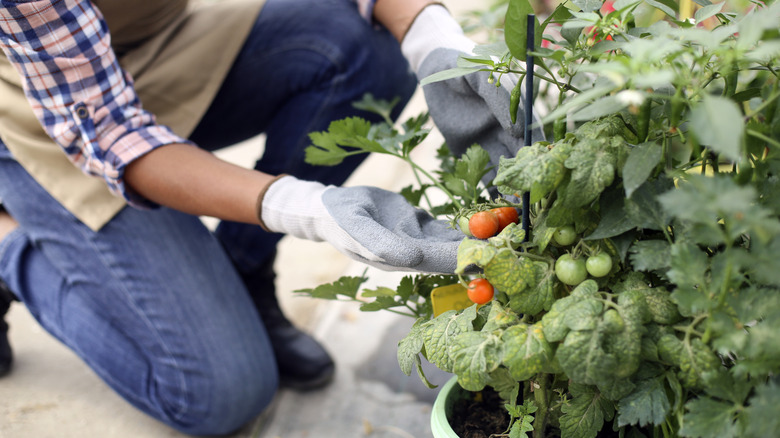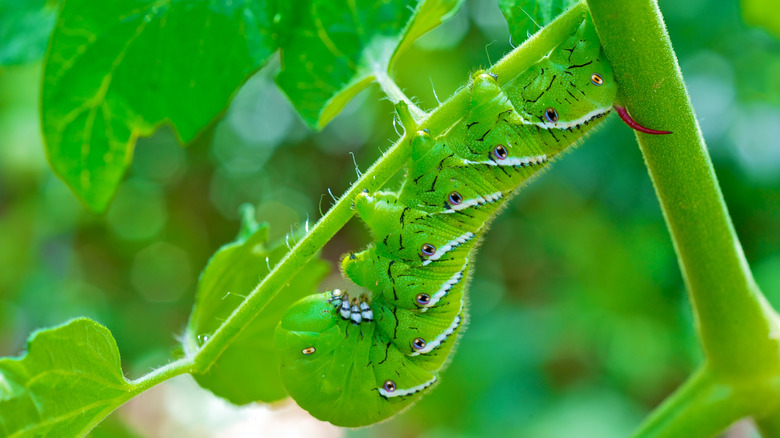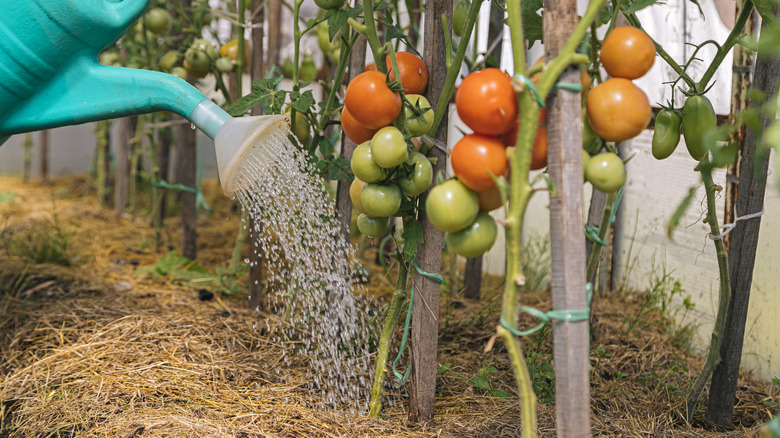Why Tomatoes May Not Be The Best Choice For Beginner Gardeners
We may receive a commission on purchases made from links.
So, you're a beginner on a mission to grow a healthy garden stocked with all kinds of fruits and veggies. Tomatoes are an obvious choice to include, right? They're a staple in so many dishes — you'll be doing your wallet a favor by growing them yourself. But be wary. "You'll find tomatoes on almost every list of the easiest vegetables to grow, but that doesn't mean that's true for everyone," notes Tiffany Selvey, House Digest's Garden Editor and in-house Master Gardener, in an exclusive interview. Put simply, these beloved fruits are very particular with their growing environment, come with problematic pests, and are prone to diseases that aren't the easiest to manage.
That's not to say tomatoes aren't a great starter plant. They can be. According to Selvey, you can find easier-to-grow varieties. Regardless, it doesn't hurt to test your green thumb with other vegetable plants, like garlic and leaf lettuce, that are less prone to pest attacks and more tolerant of different environments to start. Not convinced? Selvey shares why they may not be the right fit for your gardening. And if you're really set on giving tomatoes a try, even as a beginner, she gives tips to help.
The main reasons why tomatoes aren't beginner-friendly plants
For starters, tomatoes are difficult to grow. "These plants like to have warm feet, so soil temperature is really important for tomatoes to thrive," Tiffany Selvey explains in her exclusive chat with House Digest. This might be an issue if you live in a colder region where summer only lasts about a month or two or temperatures often dip below 60 degrees at night. Your tomato plant will likely have a hard time surviving in this scenario. But that's not all. "Extreme heat can also be an issue," Selvey points out. "When days are consistently above 100 degrees Fahrenheit, many species will stop producing blooms and fruit."
Pests can also cause problems for beginners growing tomatoes because just like humans, many insects find tomatoes to be delicious. Among those are flea beetles and aphids, and to make matters worse, they're especially tricky to control without synthetic pesticides (a no-no for organic gardeners). "Perhaps the biggest problem — literally, because they're about 4 inches long! — is the tomato hornworm," Selvey adds to the list. "This hungry caterpillar can decimate a small tomato plant overnight."
All these issues can make growing tomatoes a frustrating experience — not to mention the fungal, bacterial, and viral diseases that can affect them. It's not always easy to know what you're dealing with as a beginner, so getting familiar with the common pests that attack tomatoes in the garden is essential. Note that signs of stress like yellowing or brown leaves are also very common with tomatoes. As Selvey informs us, this May mean the soil is lean and not fertilized enough throughout the season.
What to do (and what not to do) when raising tomatoes
Tiffany Selvey emphasizes the importance of choosing the right tomato variety for your climate and growing conditions. "For those in cold climates, look for short-season tomatoes that mature quickly and tolerate cooler temps," she explains. Alaska cherry tomatoes are her top choice in this case since they mature in just 63 days. "Dwarf species, like Tiny Tim, are also a good option for those wanting to grow in a container," the expert gardener exclusively shares with House Digest.
Speaking of growing conditions, always look for disease-resistant species if you're growing your tomatoes in the ground or above it in a raised bed. Selvey's recommendations? Rutgers, Sun Gold, and Supersweet 100 for both disease resistance and flavor. "Although there are no disease-proof tomatoes, look for labels that have things like VF, F1, and N after the name or in the description," she reveals. "These are indicators the plant is resistant to certain diseases."
Moving on to the major mistake you want to avoid as a beginner gardener when growing tomatoes: improper watering. "Overwatering or poor drainage leads to root rot, while underwatering stresses the plant, preventing it from blooming," Selvey tells us. Either way, the result is usually death. Moreover, these plants do best under full sunlight (for at least eight hours in the summer, to be exact). Depriving them of that will only result in fewer crops for you. And finally, don't neglect fertilizing. "Because they are heavy feeders, they'll benefit from regular fertilization with a product like Jobe's Organics Granular Garden Fertilizer, applied according to the package instructions," Selvey advises.


